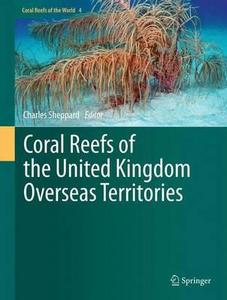The status of coral reef assemblages in the Chagos Archipelago, with implications for protected area management and climate change
Graham, Nicholas A.J., Pratchett, Morgan S., McClanahan, Tim R., and Wilson, Shaun K. (2013) The status of coral reef assemblages in the Chagos Archipelago, with implications for protected area management and climate change. In: Sheppard, Charles R.C., (ed.) Coral Reefs of the United Kingdom Overseas Territories. Coral Reefs of the World, 4 . Springer, Dordrecht, Germany, pp. 253-270.
![[img]](https://researchonline.jcu.edu.au/27421/1.hassmallThumbnailVersion/27421_Graham_et_al_2013_Book_cover.jpg)
|
Image (JPEG) (Book Cover)
- Cover Image
Download (22kB) |
|
|
PDF (Published Version)
- Published Version
Restricted to Repository staff only |
Abstract
We assess the status and structure of coral reef fish assemblages in the large remote and unfished Chagos Archipelago, comparing fish biomass and structure among atolls and across the wider western Indian Ocean. We then assess the longer term trends in reef shark abundances and the stability of fish assemblages through the 1998 climate induced habitat disturbance. Diego Garcia atoll had the lowest standing reef fish biomass estimates, while Peros Banhos and the Great Chagos Bank had the highest. Further, the biomass of larger bodied, higher trophic level, and most fishery target families was higher in the northern atolls, indicating a potential impact of the recreational fishery operating around Diego Garcia. Fish biomass in the northern atolls of Chagos was up to six times greater than estimates from even the more successful small marine protected areas elsewhere in the western Indian Ocean region. Interestingly, the biomass recorded around Diego Garcia was comparable to the highest values reported elsewhere in the region, suggesting that although the recreational fishery has had some impact at that atoll, it is far from overfished. Reef shark abundance has declined substantially since the 1970s, largely due to illegal fishing activities, however the numbers recorded in 2010 and 2012 were higher than those recorded in 1996 and 2006. The 1998 mass coral bleaching event did not have a major impact on reef fish assemblages in Chagos, with specialised coral feeding fishes being numerically dominant over less specialised coral feeders by 2012. The Chagos Archipelago provides an example of the biomass and community structure of reef fishes that many reefs likely had in the past, and also demonstrates the considerable resilience that coral reefs can exhibit when they are not otherwise stressed by chronic human pressures.
| Item ID: | 27421 |
|---|---|
| Item Type: | Book Chapter (Research - B1) |
| ISBN: | 978-94-007-5964-0 |
| ISSN: | 2213-7203 |
| Funders: | Australian Research Council (ARC) |
| Date Deposited: | 09 Jul 2013 03:57 |
| FoR Codes: | 05 ENVIRONMENTAL SCIENCES > 0502 Environmental Science and Management > 050205 Environmental Management @ 100% |
| SEO Codes: | 96 ENVIRONMENT > 9605 Ecosystem Assessment and Management > 960507 Ecosystem Assessment and Management of Marine Environments @ 100% |
| Downloads: |
Total: 736 Last 12 Months: 12 |
| More Statistics |



